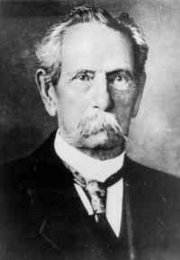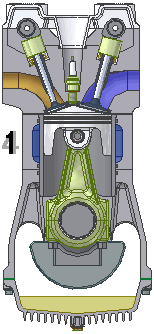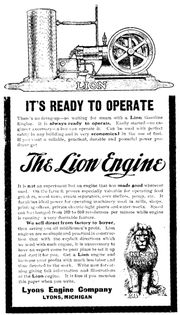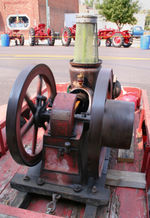|
INTERNAL COMBUSTION
AUTOMOTIVE A TO Z CHARITY CONTACT HOME SITE INDEX
|
|
The internal combustion engine is a heat engine in which the burning of a fuel occurs in a confined space called a combustion chamber. This exothermic reaction of a fuel with an oxidizer creates gases of high temperature and pressure, which are permitted to expand. The defining feature of an internal combustion engine is that useful work is performed by the expanding hot gases acting directly to cause movement, for example by acting on pistons, rotors, or even by pressing on and moving the entire engine itself.
This contrasts with external combustion engines such as steam engines which use the combustion process to heat a separate working fluid, typically water or steam, which then in turn does work, for example by pressing on a steam actuated piston.
Karl Benz
The term Internal Combustion Engine (ICE) is almost always used to refer specifically to reciprocating engines, Wankel engines and similar designs in which combustion is intermittent. However, continuous combustion engines, such as Jet engines, most rockets and many gas turbines are also very definitely internal combustion engines.
HISTORY
Non-compression
Leonardo da Vinci, in 1509, and Christiaan Huygens, in 1673, described constant pressure engines. (Leonardo's description may not imply that the idea was original with him or that it was actually constructed.)
English inventor Sir Samuel Morland used gunpowder to drive water pumps in the 17th century. In 1794, Robert Street built a compression-less engine whose principle of operation would dominate for nearly a century.
The first internal combustion engine to be applied industrially was patented by Samuel Brown in 1823. It was based on what Hardenberg calls the "Leonardo cycle," which, as this name implies, was already out of date at that time. Just as today, early major funding, in an area where standards had not yet been established, went to the best showmen sooner than to the best workers.
The Italians Eugenio Barsanti and Felice Matteucci patented the first working, efficient internal combustion engine in 1854 in London (pt. Num. 1072) but did not get into production with it. It was similar in concept to the successful Otto Langen indirect engine, but not so well worked out in detail.
In 1860, Jean Joseph Etienne Lenoir (1822 - 1900) produced a gas-fired internal combustion engine not dissimilar in appearance to a steam beam engine. This closely resembled a horizontal double acting steam engine, with cylinders, pistons, connecting-rods and fly wheel in which the gas essentially took the place of the steam. This was the first internal combustion engine to be produced in numbers.
The American Samuel Morey received a patent on April 1, 1826 for a "Gas Or Vapor Engine".
His first (1862) engine with compression having shocked itself apart, Nikolaus Otto designed an indirect acting free piston compression-less engine whose greater efficiency won the support of Langen and then most of the market, which at that time, was mostly for small stationary engines fueled by lighting gas. In 1870 in Vienna Siegfried Marcus put the first mobile gasoline engine on a handcart.
Four-stroke cycle (or Otto cycle)
Compression
The most significant distinction between modern internal combustion engines and the early designs is the use of compression and in particular of in-cylinder compression. The thermodynamic theory of idealized heat engines was established by Sadi Carnot in France in 1824. This scientifically established the need for compression to increase the difference between the upper and lower working temperatures, but it is not clear that engine designers were aware of this before compression was already commonly used. In fact it may have misled designers who attempted to emulate the Carnot cycle in ways that were not useful.
The first recorded suggestion of in-cylinder compression was a patent granted to William Barnet (English) in 1838. He apparently did not realize its advantages, but his cycle would have been a great advance if sufficiently developed.
Nikolaus Otto working with Gottlieb Daimler and Wilhelm Maybach in the 1870s developed a practical four-stroke cycle (Otto cycle) engine. The German courts, however, did not hold his patent to cover all in-cylinder compression engines or even the four stroke cycle, and after this decision in-cylinder compression became universal.
Karl Benz, working independently, was granted a patent In 1879 for his internal combustion engine, a reliable two-stroke gas engine, based on Nikolaus Otto's design of the four-stroke engine. Later Benz designed and built his own four-stroke engine that was used in his automobiles, which became the first automobiles in production.
In 1896, Karl Benz invented the boxer engine, also known as, the horizontally opposed engine, in which the corresponding pistons reach top dead centre simultaneously, thus balancing each other with respect to momentum.
Applications
Internal combustion engines are most commonly used for mobile propulsion systems. In mobile scenarios internal combustion is advantageous, since it can provide high power to weight ratios together with excellent fuel energy-density. These engines have appeared in almost all automobiles, motorbikes, many boats, and in a wide variety of aircraft and locomotives. Where very high power is required, such as jet aircraft, helicopters and large ships, they appear mostly in the form of gas turbines. They are also used for electric generators and by industry.
For low power mobile and many non-mobile applications an electric motor is a competitive alternative. In the future, electric motors may also become competitive for most mobile applications. However, the high cost, weight, and poor energy density of lead-acid batteries and even NiMH batteries and lack of affordable on board electric generators such as fuel cells has largely restricted their use to specialist applications. However recent battery advancements in lightweight Li-ion and Li-poly chemistries are bringing safety, power density, lifespan, and cost to within acceptable or even desirable levels. For example recently battery electric vehicles began to demonstrated 300 miles of range on Lithium, now improved power makes them appealing for plug-in hybrid electric vehicles whose electric range is less critical having internal combustion for unlimited range..
Internal combustion mechanics
The potato cannon uses the basic principle behind any reciprocating internal combustion engine: If you put a tiny amount of high-energy fuel (like gasoline) in a small, enclosed space and ignite it, an incredible amount of energy is released in the form of expanding gas. You can use that energy to propel a potato 500 feet. In this case, the energy is translated into potato motion. You can also use it for more interesting purposes. For example, if you can create a cycle that allows you to set off explosions like this hundreds of times per minute, and if you can harness that energy in a useful way, what you have is the core of a car engine!
Almost all cars currently use what is called a four-stroke combustion cycle to convert gasoline into motion. The four-stroke approach is also known as the Otto cycle, in honor of Nikolaus Otto, who invented it in 1867. The four strokes are illustrated in Figure 1. They are:
Intake stroke Compression stroke Combustion stroke Exhaust stroke
Operation
All internal combustion engines depend on the exothermic chemical process of combustion: the reaction of a fuel, typically with air, although other oxidisers such as nitrous oxide may be employed. Also see stoichiometry.
The most common fuels in use today are made up of hydrocarbons and are derived from petroleum. These include the fuels known as diesel, gasoline and liquified petroleum gas. Most internal combustion engines designed for gasoline can run on natural gas or liquified petroleum gases without modifications except for the fuel delivery components. Liquid and gaseous biofuels, such as Ethanol can also be used. Some can run on Hydrogen, however this can be dangerous. Hydrogen burns with a colorless flame, and modifications to the cylinder block, cylinder head, and head gasket are required to seal in the flame front.
All internal combustion engines must have a means of ignition to promote combustion. Most engines use either an electrical or a compression heating ignition system. Electrical ignition systems generally rely on a lead-acid battery and an induction coil to provide a high voltage electrical spark to ignite the air-fuel mix in the engine's cylinders. This battery can be recharged during operation using an alternator driven by the engine. Compression heating ignition systems, such as diesel engines and HCCI engines, rely on the heat created in the air by compression in the engine's cylinders to ignite the fuel.
Once successfully ignited and burnt, the combustion products, hot gases, have more available energy than the original compressed fuel/air mixture (which had higher chemical energy). The available energy is manifested as high temperature and pressure which can be translated into work by the engine. In a reciprocating engine, the high pressure product gases inside the cylinders drive the engine's pistons.
Once the available energy has been removed the remaining hot gases are vented (often by opening a valve or exposing the exhaust outlet) and this allows the piston to return to its previous position (Top Dead Center - TDC). The piston can then proceed to the next phase of its cycle, which varies between engines. Any heat not translated into work is a waste product and is removed from the engine either by an air or liquid cooling system.
Illustration of several key components in a typical four-stroke engine
Parts
The parts of an engine vary depending on the engine's type. For a four-stroke engine, key parts of the engine include the crankshaft (purple), one or more camshafts (red and blue) and valves. For a two-stroke engine, there may simply be an exhaust outlet and fuel inlet instead of a valve system. In both types of engines, there are one or more cylinders (grey and green) and for each cylinder there is a spark plug (darker-grey), a piston (yellow) and a crank (purple). A single sweep of the cylinder by the piston in an upward or downward motion is known as a stroke and the downward stroke that occurs directly after the air-fuel mix in the cylinder is ignited is known as a power stroke.
A Wankel engine has a triangular rotor that orbits in an epitroichoidal (figure 8 shape) chamber around an eccentric shaft. The four phases of operation (intake, compression, power, exhaust) take place in separate locations, instead of one single location as in a reciprocating engine.
A Bourke Engine uses a pair of pistons integrated to a Scotch Yoke that transmits reciprocating force through a specially designed bearing assembly to turn a crank mechanism. Intake, compression, power, and exhaust all occur in each stroke of this yoke.
Classification
There is a wide range of internal combustion engines corresponding to their many varied applications. Likewise there is a wide range of ways to classify internal-combustion engines, some of which are listed below.
Although the terms sometimes cause confusion, there is no real difference between an "engine" and a "motor." At one time, the word "engine" (from Latin, via Old French, ingenium, "ability") meant any piece of machinery. A "motor" (from Latin motor, "mover") is any machine that produces mechanical power. Traditionally, electric motors are not referred to as "engines," but combustion engines are often referred to as "motors."
Principles of operation
Reciprocating:
Rotary:
Continuous combustion:
Engine cycle
Engines based on the two-stroke cycle use two strokes (one up, one down) for every power stroke. Since there are no dedicated intake or exhaust strokes, alternative methods must be used to scavenge the cylinders. The most common method in spark-ignition two-strokes is to use the downward motion of the piston to pressurize fresh charge in the crankcase, which is then blown through the cylinder through ports in the cylinder walls. Spark-ignition two-strokes are small and light (for their power output), and mechanically very simple. Common applications include snowmobiles, lawnmowers, chain saws, jet skis, mopeds, outboard motors and some motorcycles. Unfortunately, they are also generally louder, less efficient, and far more polluting than their four-stroke counterparts, and they do not scale well to larger sizes. Interestingly, the largest compression-ignition engines are two-strokes, and are used in some locomotives and large ships. These engines use forced induction to scavenge the cylinders.
Engines based on the four-stroke cycle or Otto cycle have one power stroke for every four strokes (up-down-up-down) and are used in cars, larger boats and many light aircraft. They are generally quieter, more efficient and larger than their two-stroke counterparts. There are a number of variations of these cycles, most notably the Atkinson and Miller cycles. Most truck and automotive Diesel engines use a four-stroke cycle, but with a compression heating ignition system it is possible to talk separately about a diesel cycle.
The Wankel engine operates with the same separation of phases as the four-stroke engine (but with no piston strokes, would more properly be called a four-phase engine), since the phases occur in separate locations in the engine; however like a two-stroke piston engine, it provides one power 'stroke' per revolution per rotor, giving it similar space and weight efficiency. The Bourke cycle's combustion phase more closely approximates constant volume combustion than either four stroke or two stroke cycles do. It also uses less moving parts, hence needs to overcome less friction than the other two reciprocating types have to. In addition, its greater expansion ratio also means more of the heat from its combustion phase is utilized than is used by either four stroke or two stroke cycles.
1906 gasoline engine
Fuel and oxidizer types
Fuels used include gasoline (British term: petrol), liquified petroleum gas, vapourized petroleum gas, compressed natural gas, hydrogen, diesel fuel, JP18 (jet fuel), landfill gas, biodiesel, peanut oil, ethanol, methanol (methyl or wood alcohol). Even fluidised metal powders and explosives have seen some use. Engines that use gases for fuel are called gas engines and those that use liquid hydrocarbons are called oil engines. However, gasoline engines are unfortunately also often colloquially referred to as 'gas engines'.
The main limitations on fuels are that the fuel must be easily transportable through the fuel system to the combustion chamber, and that the fuel release sufficient energy in the form of heat upon combustion to make use of the engine practical.
The oxidiser is typically air, and has the advantage of not being stored within the vehicle, increasing the power-to-weight ratio. Air can, however, be compressed and carried aboard a vehicle. Some submarines are designed to carry pure oxygen or hydrogen peroxide to make them air-independent. Some race cars carry nitrous oxide as oxidizer. Other chemicals such as chlorine or fluorine have seen experimental use; but mostly are impractical.
Diesel engines are generally heavier, noisier and more powerful at lower speeds than gasoline engines. They are also more fuel-efficient in most circumstances and are used in heavy road vehicles, some automobiles (increasingly more so for their increased fuel efficiency over gasoline engines), ships, railway locomotives, and light aircraft. Gasoline engines are used in most other road vehicles including most cars, motorcycles and mopeds. Note that in Europe, sophisticated diesel-engined cars have become quite prevalent since the 1990s, representing around 40% of the market. Both gasoline and diesel engines produce significant emissions. There are also engines that run on hydrogen, methanol, ethanol, liquefied petroleum gas (LPG) and biodiesel. Paraffin and tractor vaporising oil (TVO) engines are no longer seen.
Some have theorized that in the future hydrogen might replace such fuels. Furthermore, with the introduction of hydrogen fuel cell technology, the use of internal combustion engines may be phased out. The advantage of hydrogen is that its combustion produces only water. This is unlike the combustion of hydrocarbons, which also produces carbon dioxide, a major cause of global warming, as well as carbon monoxide, resulting from incomplete combustion. The big disadvantage of hydrogen in many situations is its storage. Liquid hydrogen has extremely low density- 14 times lower than water and requires extensive insulation, whilst gaseous hydrogen requires very heavy tankage. Although hydrogen has a higher specific energy, the volumetric energetic storage is still roughly five times lower than petrol, even when liquified. (The 'Hydrogen on Demand' process, designed by Steven Amendola, creates hydrogen as it is needed, but this has other issues, such as the raw materials being relatively expensive.)
Single cylinder gasoline engine c. 1910 Cylinders
Internal combustion engines can contain any number of cylinders with numbers between one and twelve being common, though as many as 30 have been used. Having more cylinders in an engine yields two potential benefits: First. the engine can have a larger displacement with smaller individual reciprocating masses (that is, the mass of each piston can be less) thus making a smoother running engine (since the engine tends to vibrate as a result of the pistons moving up and down). Second, with a greater displacement and more pistons, more fuel can be combusted and there can be more combustion events (that is, more power strokes) in a given period of time, meaning that such an engine can generate more torque than a similar engine with fewer cylinders. The down side to having more pistons is that, over all, the engine will tend to weigh more and tend to generate more internal friction as the greater number of pistons rub against the inside of their cylinders. This tends to decrease fuel efficiency and rob the engine of some of its power. For high performance gasoline engines using current materials and technology (such as the engines found in modern automobiles), there seems to be a break point around 10 or 12 cylinders, after which addition of cylinders becomes an overall detriment to performance and efficiency, although exceptions such as the W-16 engine from Volkswagen exist.
Ignition system
Internal combustion engines can be classified by their ignition system. Today most engines use an electrical or compression heating system for ignition. However outside flame and hot-tube systems have been used historically. Nikola Tesla gained one of the first patents on the mechanical ignition system with U.S. Patent 609250, "Electrical Igniter for Gas Engines", on 16 August 1898.
Fuel systems
Often for simpler reciprocating engines a carburetor is used to supply fuel into the cylinder. However, exact control of the correct amount of fuel supplied to the engine is impossible.
Larger gasoline engines such as used in cars have mostly moved to fuel injection systems. LPG engines use a mix of fuel injection systems and closed loop carburetors. Diesel engines always use fuel injection.
Other internal combustion engines like jet engines use burners, and rocket engines use various different ideas including impinging jets, gas/liquid shear, preburners and many other ideas.
Engine configuration
Internal combustion engines can be classified by their configuration which affects their physical size and smoothness (with smoother engines producing less vibration). Common configurations include the straight or inline configuration, the more compact V configuration and the wider but smoother flat or boxer configuration. Aircraft engines can also adopt a radial configuration which allows more effective cooling. More unusual configurations, such as "H", "U", "X", or "W" have also been used.
Multiple-crankshaft configurations do not necessarily need a cylinder head at all, but can instead have a piston at each end of the cylinder, called an opposed piston design. This design was used in the Junkers Jumo 205 diesel aircraft engine, using two crankshafts, one at either end of a single bank of cylinders, and most remarkably in the Napier Deltic diesel engines, which used three crankshafts to serve three banks of double-ended cylinders arranged in an equilateral triangle with the crankshafts at the corners. It was also used in single-bank locomotive engines, and continues to be used for marine engines, both for propulsion and for auxiliary generators. The Gnome Rotary engine, used in several early aircraft, had a stationary crankshaft and a bank of radially arranged cylinders rotating around it.
Engine capacity
An engine's capacity is the displacement or swept volume by the pistons of the engine. It is generally measured in litres or cubic inches for larger engines and cubic centimetres (abbreviated to cc's) for smaller engines. Engines with greater capacities are usually more powerful and provide greater torque at lower rpms but also consume more fuel.
Apart from designing an engine with more cylinders, there are two ways to increase an engine's capacity. The first is to lengthen the stroke and the second is to increase the piston's diameter. In either case, it may be necessary to make further adjustments to the fuel intake of the engine to ensure optimal performance.
An engine's quoted capacity can be more a matter of marketing than of engineering. The Morris Minor 1000, the Morris 1100, and the Austin-Healey Sprite Mark II all had engines of the same stroke and bore according to their specifications, and were from the same maker. However the engine capacities were quoted as 1000cc, 1100cc and 1098cc respectively in the sales literature and on the vehicle badges.
Engine pollution
Generally internal combustion engines, particularly reciprocating internal combustion engines, produce moderately high pollution levels, due to incomplete combustion of carbonaceous fuel, leading to carbon monoxide and some soot along with oxides of nitrogen & sulfur and some unburnt hydrocarbons depending on the operating conditions and the fuel/air ratio.
Diesel engines produce a wide range of pollutants including aerosols of many small particles that are believed to penetrate deeply into human lungs.
Electric vehicles offer the most promising solution to clean motoring. It is hoped that instant EV refueling via cartridge exchange will accelerate the acceptance of EVs. See the Blueplanet Ecostar - an electric land speed record racing car with built in cartridge refueling for each run.
Bibliography
LINKS
ARTICLES
DATA
|
|
The content of this website is copyright © and design copyright 1991 and 2018 Electrick Publications. All rights reserved. The bird logos and names Bluebird and Blue Planet are trademarks. The BE2 and BE3 vehicle shape and configuration are registered designs ®. All other trademarks are hereby acknowledged. Max Energy Limited is an educational charity.
|




